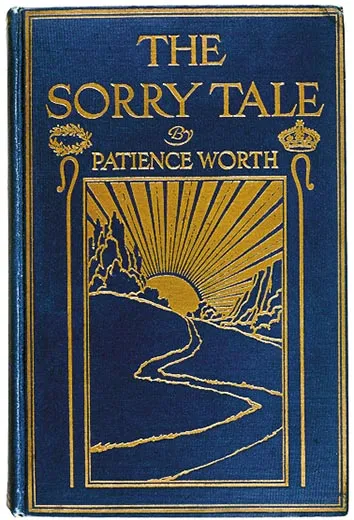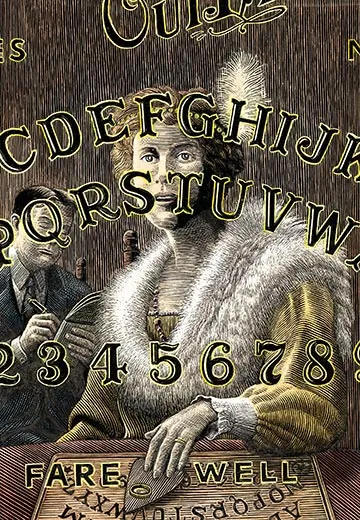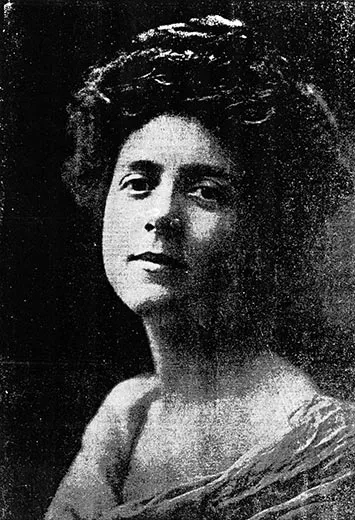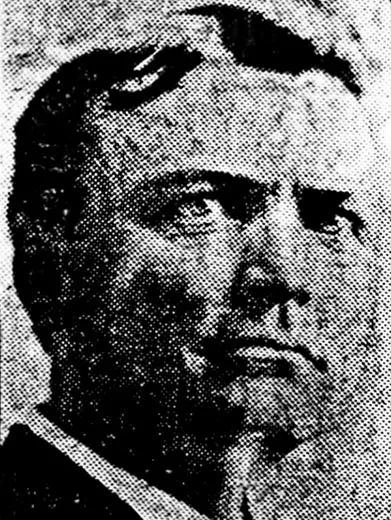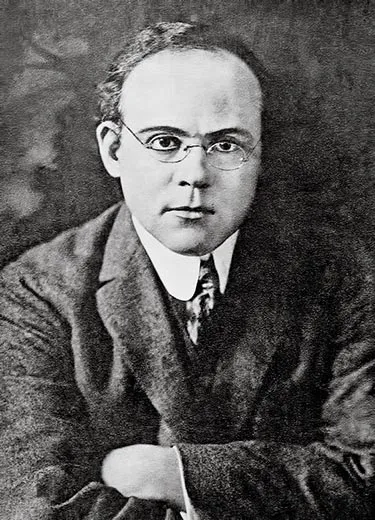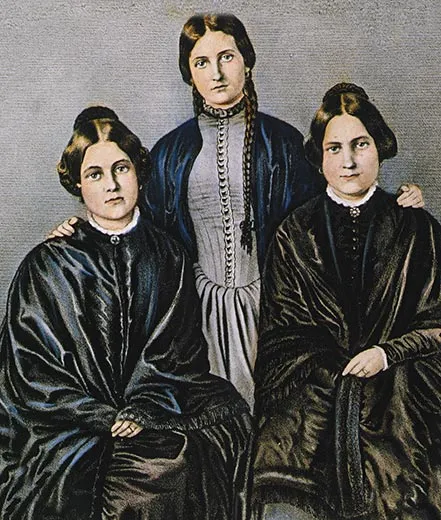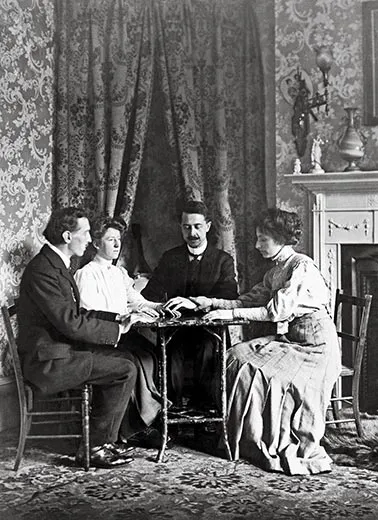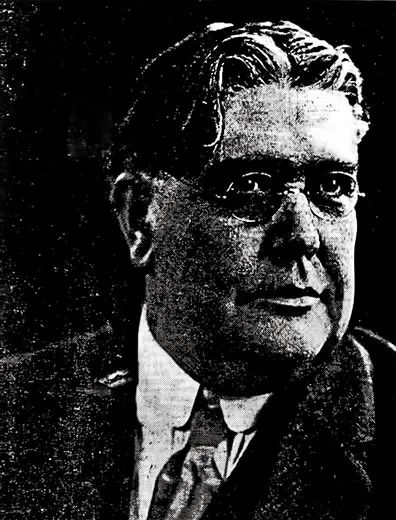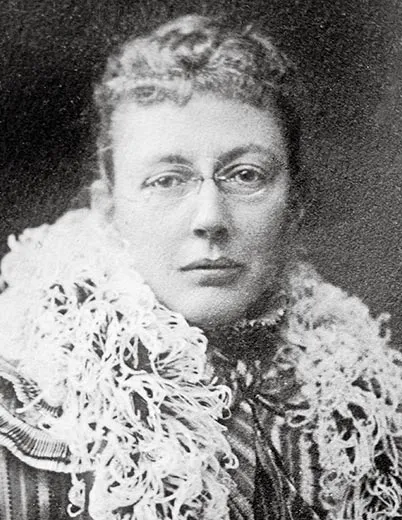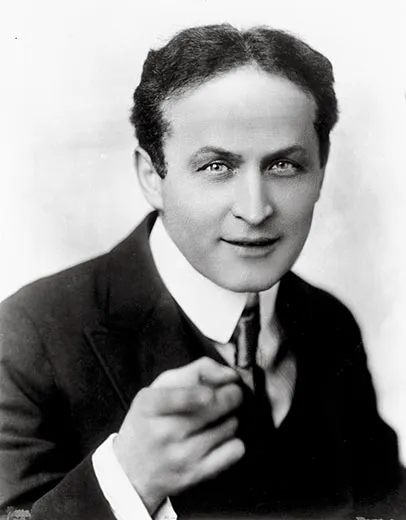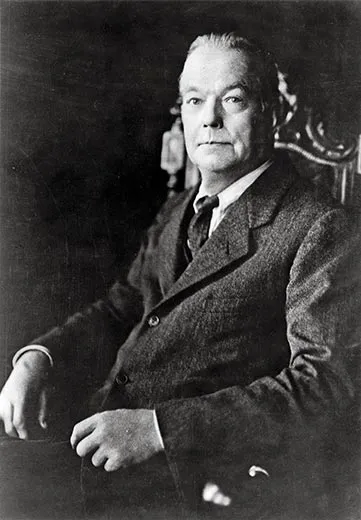Patience Worth: Author From the Great Beyond
Pearl Curran, a St. Louis housewife, channeled a 17th-century spirit to the heights of 20th-century literary stardom
/https://tf-cmsv2-smithsonianmag-media.s3.amazonaws.com/filer/Ghost-Writer-Pearl-Curran-631.jpg)
Editor's note: An earlier version of this article stated that nothing ever came of a movie deal for Pearl's story. In fact, there was a film titled "Whatever happened to Rosa." This version of the article has been updated with that information.
One cool autumn evening in 1919, a crowd of prominent New Yorkers jammed the parlor of an East Side town house to meet a writing prodigy named Patience Worth. A prolific charmer who was known for her flashy verbal stunts and quick wit, Patience dictated two original poems—about Russia and the Red Cross—in rapid succession, followed by a lyrical tribute to an editor friend. Though she seemed to compose the works on the spot, her words flowed with the quality of messages punched out by teletype. Poet Edgar Lee Masters was among the astonished guests. “There is no doubt...she is producing remarkable literature,” the author of Spoon River Anthology told a reporter, though “how she does it I cannot say.” Nor could he say how Patience looked, though she was thought to be young and pretty, with wavy red hair and large brown eyes. No one, however, actually saw her. She wasn’t real. She was an ambitious, hard-working spirit.
Speaking through a Ouija board operated by Pearl Lenore Curran, a St. Louis housewife of limited education, Patience Worth was nothing short of a national phenomenon in the early years of the 20th century. Though her works are virtually forgotten today, the prestigious Braithwaite anthology listed five of her poems among the nation’s best published in 1917, and the New York Times hailed her first novel as a “feat of literary composition.” Her output was stunning. In addition to seven books, she produced voluminous poetry, short stories, plays and reams of sparkling conversation—nearly four million words between 1913 and 1937. Some evenings she worked on a novel, a poem and a play simultaneously, alternating her dictation from one to another without missing a beat. “What is extraordinary about this case is the fluidity, versatility, virtuosity and literary quality of Patience’s writings, which are unprecedented in the history of automatic writing by mediums,” says Stephen Braude, a professor of philosophy at the University of Maryland Baltimore County and a past president of the American Parapsychological Association, who has written widely on paranormal phenomena.
Almost overnight, Patience transformed Pearl Curran from a restless homemaker plagued by nervous ailments into a busy celebrity who traveled the country giving performances starring Patience. Night after night Pearl, a tall, blue-eyed woman in a fashionable dress, would sit with her Ouija board while her husband, John, recorded Patience’s utterances in shorthand. Those who witnessed the performances, some of them leading scholars, feminists, politicians and writers, believed they’d seen a miracle. “I still confess myself completely baffled by the experience,” Otto Heller, dean of the Graduate School at Washington University in St. Louis, recalled years later.
Through Pearl, Patience claimed to be an unmarried Englishwoman who had emigrated to Nantucket Island in the late 1600s and been killed in an Indian raid. For three centuries, she said, she’d searched for an earthly “crannie” (as in “cranium”) to help her fulfill a burning literary ambition. She’d found it at last in Pearl.
Patience appeared on the scene just when spiritualism, enjoying its last great American revival, collided with the age of science, and a brigade of investigators, including magician Harry Houdini, prowled the nation to expose bogus mediums. Since most mediums were women—the spiritualist movement accorded women social status they rarely attained elsewhere—this crusade turned into an epic battle of the sexes: supposed hard-nosed men of science against swooning female seers.
A long list of psychical sleuths, psychologists and other skeptics tried to debunk Patience and prove that Pearl was a fraud. No one succeeded. Scholars who examined Patience’s work marveled at her deep knowledge of the plants, customs, clothing and cuisine of several historical epochs, stretching back to the ancients, and at her ability to draw on this vast knowledge without hesitation. “Maybe there was some preparation going on during the day, yet that alone cannot account for the material Pearl was producing,” says Daniel Shea, professor emeritus of English at Washington University, who has studied the case and believes it can be explained without citing supernatural forces.
The Patience Worth case remains one of the most tantalizing literary mysteries of the last century, a window onto a vanished era when magic seemed to exist because so many people believed in it. In the decades since Pearl Curran’s death, in 1937, no one has explained how she produced Patience’s writing. Combing through the voluminous archives, however, a modern sensibility starts to see clues and patterns that may not have been apparent at a time when science was just starting to explore the far reaches of the human mind.
I first heard about patience worth 20 years ago, while researching a biography of Hadley Richardson, Ernest Hemingway’s first wife and muse; Richardson had been born and raised in St. Louis, and her mother, sister and brother-in-law had occasionally attended the biweekly Patience Worth sessions in the Currans’ home. Over the years, I collected bits of information about the story, which eventually filled two accordion files in my office. Recently, I spent time at the Missouri Historical Society in St. Louis, where Patience’s writings and conversation are meticulously recorded in 29 volumes.
Reading over the material, I was struck by the vibrancy of Patience’s personality, the authenticity of her voice and her gift for imagery. Though by modern standards her novels are full of arcane subjects and slow-moving plots, her language brims with feeling and employs a wholly original syntax. She referred to the “me o’ me” for the essence of individuality and the “inman” for the soul. She called her writing her “put” or “weaving,” her home her “hut.” She loved children and nature but also had a taste for finery, and she chafed at doing humble household chores. She was deeply religious and, even at her most acerbic and humorous, displayed an underlying moral seriousness. In marked contrast to the vague, flighty Pearl, Patience also had a potent sense of self. “A phantom?” she protested when a journalist suggested that she’d never been a real person. “Weel enough, prove thyself to me!”
She cultivated an air of mystery. Except for giving two possible dates for her birth—1649 and 1694—Patience refused to locate herself in time other than in the “here.” Her reticence extended to other questions about her life on earth. After suggesting that she’d been killed by an Indian, she was asked what tribe her killer belonged to. “Would ye with a blade at thy throat seek the [affiliation] of thine assassin?” she replied.
Over time, however, she let slip some key personal details. Patience hinted that she’d come from Portesham in Dorsetshire, England, near where Thomas Hardy was born in 1840. She never mentioned her father but said her mother had worked as a seamstress for a nobleman’s family. She indicated that she had been buried on Nantucket and that a tree had grown out of her dust.
Sometimes, Pearl said, she had sharp visions of Patience. In one, she saw Patience as a slight, pretty woman dressed in a flowing gray cape as she galloped on horseback with other riders toward a huge three-masted ship docked at a landing. When the riders reached the dock, Patience pushed back her hood, and, Pearl said, showed her face: she was about 30, much younger than Pearl had thought, with large brown eyes, a determined mouth and masses of deep red hair that tumbled around her shoulders in lustrous waves.
Occasionally, Patience’s recollections of her girlhood were so vivid they seemed to have been lifted from the diary of a 17th-century English maid. “Well I remember a certain church,” she once dictated, “with its wee windows and its prim walls, with its sanctity and meekness, with its aloofness and chilling godliness. Well I remember the Sabbath and its quietude of uneasiness, wherein the creaking of the wood was an infernalism, the droning and scuffing of the menfolk’s shoes and the rustle of the clothes of the dames and maids, the squeaking of the benches, and the drowsy humming of some busy bee who broke the Sabbath’s law. Aye, well I remember the heat that foretold the wrath of God, making the Good Man [the parson] sweat. Aye, and Heaven seemed far, far.”
So alive was Patience’s language that many of those who sat with Pearl at the Ouija board felt they could see the gestures and facial expressions accompanying her words. “Patience Worth is arch and coquettish with a mind of no small power and altogether loveable,” wrote William Marion Reedy, editor of the Mirror, one of the nation’s leading journals of opinion and literary criticism. The overweight editor started out a skeptic, but quickly fell in thrall to this glib, hyper-literate personality, who affectionately called him “Fatawide.” He had “learned to love her as a person more real than many whose hands I grasp,” he confessed in the Mirror.
Before Patience, Pearl Curran’s life had the feel of a tightly laced corset, one that over the years had narrowed and grown more constrained. Born in Mound City, Illinois, in 1883, she was the only child of George Pollard, an itinerant railroad employee and newspaperman, and his high-strung, ambitious wife, Mary. The Pollards moved a great deal—from Illinois to southern Missouri to Texas—as Pollard sought better-paying jobs. Pearl’s mother was extremely distressed by her husband’s inability to provide a stable living and, after she had a nervous breakdown when Pearl was 4, sent her daughter to live for a while with the child’s grandmother in St. Louis.
Though not a good student, Pearl was remembered by a childhood friend as a great talker who “loved to tell jokes or funny stories about people.” What’s more, she had a good memory, and the letters she wrote were full of lively descriptions. From an early age Pearl showed an interest in music, which her mother encouraged. The family’s meager resources were poured into Pearl’s piano, singing, acting and elocution lessons. Pearl went along with it, she said, because she wanted “to lift myself out of a hopeless future.” But at 13, she had what was termed a nervous collapse and dropped out of school.
Throughout this troubled girlhood, Pearl’s only known connection to spiritualism came when she went to live briefly in Chicago with an uncle who was the minister of a storefront spiritualist church, and, according to one family member, “an arch faker.” Pearl played piano in the church, where services revolved around attempts to contact the dead, but she “didn’t like the crowd that came, and the whole thing was repulsive to me,” she would recall later.
Desperate to become a singer, Pearl worked at shops in Chicago and then at Marshall Field’s department store to pay for voice lessons. She kept them up until at 24 she married John Curran, a widowed immigration official and sometime businessman 12 years her senior. In 1908 the newlyweds moved to St. Louis, which was pulsing with prosperity. The nation’s top producer of beer and a manufacturing center for leather goods, St. Louis boasted four daily newspapers, sumptuous mansions and beautiful parks.
Not since the Civil War had there been such interest in spiritualism, which had been born in the United States in 1848 when two sisters, Kate and Margaret Fox, claimed to have contacted a dead peddler through telegraphic rapping in their upstate New York farmhouse. Soon, scores of self-anointed mediums (including their sister Leah) burst on the scene, most of them women, whose passivity and purity, it was believed, made them ideal vessels to receive news from the Other Side.
At the time, Ouija boards—parlor toys that supposedly facilitated contact with the dead—were a national craze. Pearl Curran, though, claimed to have no interest in such nonsense. Thirty years old in 1913, she was pretty, though exceptionally thin, with thick ginger hair piled on her head in a Gibson girl topknot. Childless—and heartbroken over it—she had little but housework and cooking to occupy her days. She sang in the church choir, entertained, played cards and went to the movies with her husband. One acquaintance described her as a classic Victorian hysteric, plagued by phantom ailments—“a prospective visit of the stork, a tumor, consumption, which all failed to materialize.”
Other than her mother, who lived with the Currans, and a teenage stepdaughter, Julie, Pearl’s chief companion at this time was Emily Grant Hutchings, the wife of one of John Curran’s friends. A robust, black-haired devotee of spiritualism, Emily was also a prolific writer whose poetry, stories and art criticism appeared in many publications, including Cosmopolitan, the Atlantic Monthly, McClure’s and the Mirror.
In the fall of 1912, soon after Pearl’s father died, Emily suggested that she and Pearl try to contact him through Emily’s Ouija board. Twice a week, while their husbands played pinochle in the next room, Emily and Pearl sat facing each other on stiff-backed chairs in Pearl’s parlor, the board balanced on their knees and their fingers placed lightly on the heart-shaped planchette. Guided supposedly by supra-normal forces, the pointer spelled out messages by alighting on the letters of the alphabet printed on the board. Though occasionally the board spelled out intelligible words—usually family names—it gave up mostly gibberish. To Pearl it was all “silly chatter,” a kind of fortuneteller’s babble, she recalled in a 1915 interview with the St. Louis Globe-Democrat.
Then on the evening of July 8, 1913, no sooner had Emily and Pearl placed their fingers on the pointer than it raced to the letters M, A, N and Y. Within minutes the women had this message: “Many moons ago I lived. Again I come—Patience Worth my name.” Emily was immediately convinced they’d made contact with a spirit and took control of questioning Patience.
Emily: Where was your home?
Patience: Across the sea.
Emily: In what city or country?
Patience: About me ye would know much. Yesterday is dead. Let thy mind rest as to the past.
Over the next weeks it became clear to Pearl that she, not Hutchings, was the spirit’s medium. She said she was astounded by the pictures and words that played through her mind like a movie as soon as she sat at the Ouija board. Pearl described this realization as “when the bolt fell.” News of the phenomenon traveled quickly through the Currans’ middle-class neighborhood, and they were deluged with requests to witness Pearl communing with Patience. In no time large groups of people were gathering regularly in the Currans’ home. These evenings had the atmosphere of church suppers, with a buffet on the dining table, children running about and a few men smelling up the parlor with cigars. There were no dimmed lights, burning candles, chanting or any other trappings of the occult.
One by one, visitors would be called to sit with Pearl, who would let them question Patience or request a poem on a specific topic. Sometimes, when Patience used a particularly odd word, John Curran would interrupt his note-taking to look it up in an encyclopedia. Invariably an impulse to write would seize Patience, and she would announce that it was time to work on one of her novels or plays. Then the pointer would fly around the board and Pearl would call out words at the rate of 1,500 or so an hour, with “never a second’s hesitation [and] never an alteration,” noted a social worker who attended a Patience Worth evening in 1918.
Though Patience sometimes showed an uncanny knowledge of what was going on in her guests’ lives and thoughts, she refused to predict the future and only occasionally settled burning historical questions. When William Marion Reedy, for example, asked her who wrote Shakespeare’s plays, Patience replied, “The word of the skin-shoon man [the actor] ...be his,” a cryptic answer but one reasonably interpreted as affirming Shakespeare’s authorship.
At first Pearl spelled out every letter with the Ouija board, but as time passed, the mere touch of her hand on the pointer loosed a flood of spoken words. Eventually, she abandoned the board entirely; a feeling of slight pressure in her head would announce Patience’s arrival, and Pearl would begin reciting.
While Pearl recited, she behaved normally, with her eyes open and her senses alert to the faces and noises around her. “Sometimes, she looks over to a guest while writing and asks some question entirely foreign to what she is spelling out; again answers the telephone or inquires what the message was; exchanges a few words of greeting to late visitors as they enter and goes on with the work without a moment’s hesitation,” recalled a visitor. Occasionally, she’d even smoke a cigarette.
In 1915, Casper S. Yost, the frail, deeply religious editorial page editor of the St. Louis Globe-Democrat, persuaded the Currans to let him write about some sessions he had witnessed. His series of articles became the basis of a popular 1916 book, Patience Worth: A Psychic Mystery (published by Henry Holt, who was himself a spiritualist). Appearing at the height of a war-inspired fad for books by and about spirits, it featured a hearty sampling of Patience’s poetry, aphorisms, proverbs and conversation, and it turned Patience and Pearl into celebrities. “Patience Worth[’s] messages out of the darkness never sink to the commonplace level, but always show high intelligence and sometimes are even tipped with the flame of genius,” said the New York Times, echoing other newspaper reviews across the country.
Yost’s book was followed in 1917 by Patience’s first novel, The Sorry Tale, also published by Holt. The story of one of the thieves crucified with Jesus, it received rave reviews. The next year, the Joint Committee of Literary Arts of New York named Patience one of the nation’s outstanding authors. That May, Holt published Patience’s second novel, Hope Trueblood, the tale of a fatherless girl in Victorian England. It was written in a 19th-century voice dramatically different from The Sorry Tale, a fact that Pearl explained by Patience’s urge to widen her audience. But by then the spirit-author fad had begun to fade, and Hope Trueblood received mixed reviews. The esteemed Atlantic Monthly essayist Agnes Repplier delivered a general condemnation of Patience and her otherworldly ilk as “authors of books as silly as they are dull.”
But who was Patience? A fraud? A spirit? The product of Pearl Curran’s subconscious mind?
No sooner had she appeared than an uproar ensued in the press, as a variety of experts—philosophers, psychiatrists, neurologists, historians, semanticists and literati—began weighing in from around the nation, Canada and Britain. Psychoanalyst Wilfrid Lay, writing in the literary journal The Bookman, insisted that Patience’s writing was merely “the automatic activities of [Pearl’s] Unconscious.” Writer Mary Austin in the Unpartizan Review attributed Patience to “an excessive discharge of phosphorus” in Pearl’s brain. Other observers explained the phenomenon as the result of inherited “nerve cells” or a “talent that has been transmitted over the heads of [Pearl’s] ancestors to her.”
Pearl steadfastly refused to cooperate with the psychologists who wanted to study her, but that didn’t stop Charles Cory, chairman of the philosophy department at Washington University, who’d been present at several Patience Worth sessions, from claiming to have solved the mystery. In a long article in the Psychological Review in 1919, Cory argued that the case could be explained by multiple personality. Though Cory was confounded by Pearl’s ability to remain herself while Patience dictated to her—multiples usually inhabit only one personality at a time—he concluded that while Pearl went about her housework during the day, her “other self” composed her novels and poems.
Investigators into the “supernormal” powers of the human mind had recognized the importance of the subconscious long before Freud did. Some of the most brilliant men of the day were associated with the American Society for Psychical Research (ASPR), including the founder, Harvard psychologist William James (brother of novelist Henry), historian Francis Parkman and Theodore Roosevelt. By the early 20th century, however, the field had become rife with cranks and crackpots whose insistence on scientific objectivity belied their secret beliefs in magic.
James Hervey Hyslop, head of the ASPR from 1905 until his death in 1920, was typical. After earning a PhD in philosophy from Johns Hopkins University, Hyslop had joined the faculty of Columbia University in 1889 as a professor of logic and ethics, but by the early 1900s he had given up his post to devote himself to psychical research. He claimed that he could determine the authenticity of spirit communication through a system of “cross references,” whereby several mediums who were unknown to each other would receive related messages from a spirit. As soon as he heard about Patience Worth, he wrote to the Currans, urging them to submit to his cross-reference test. They refused. Anger at their rejection may have been behind the attack he launched in the April 1916 issue of the Journal of the American Society for Psychical Research. The case of Patience Worth was “a fraud and a delusion,” he wrote. “Notoriety and making a fortune were the primary influences acting on the parties concerned.”
A decade later, Hyslop’s judgment was emphatically contradicted by his successor at the ASPR, Walter Franklin Prince. A one-time Episcopal and Methodist minister and amateur magician who had a PhD in psychology from Yale, Prince had grown up with a passion for puzzles. He became fascinated by abnormal psychology after he and his wife adopted a girl diagnosed with multiple personalities. This led to an interest in the psychology of mediums. Some of Prince’s research was published in the Journal of the ASPR, and soon Prince became the society’s chief investigating officer, working with Harry Houdini to expose fake mediums, who “came to fear him like the plague,” according to a friend.
Pearl, however, showed no fear. After turning down all similar requests over the years, she welcomed Prince into her life for reasons that remain unclear, and he spent several weeks in St. Louis reading over the entire Patience Worth record, interviewing Pearl, her stepdaughter and her friends and sitting in on long sessions with Patience. In 1927, he published his findings in a 500-page book, The Case of Patience Worth, in which his admiration for Patience’s “marvelous imagination...gift of poetic expression...singular wisdom and spirituality” shines from every page.
Finding no evidence that “ordinary” Pearl had produced the Patience Worth material either consciously or unconsciously, Prince concluded that “some cause operating through but not originating in...Mrs. Curran must be acknowledged.”
Among the Currans’ neighbors and friends in St. Louis, opinion divided along gender lines. Irving Litvag, author of Singer in the Shadows, a 1972 book on the case, interviewed several women who’d witnessed the Patience sessions and found “complete unanimity of opinion among them: They regard the Patience Worth case as the most remarkable activity in which they ever participated; they considered Mrs. Curran to be completely honest; they remember her as an exuberant, witty, ‘cut-up’ type of person; [though] their husbands, to a man, never were convinced of the genuineness of the phenomenon.”
Indeed, some of these men thought Pearl was unbalanced. “I wonder if John H. Curran ever gives a thought to the psychological and pathological aspect of Mrs. Curran’s condition? He better,” William Clark Breckenridge, a St. Louis businessman, wrote to a friend.
Those who disdained spiritualism grasped at any evidence that Pearl was a fraud. A reader of the Mirror, for example, pointed out that Patience Worth was the name of a character in To Have and To Hold, a popular 1900 bodice-ripper by novelist Mary Johnston set in Colonial America. Pearl said that she hadn’t read the novel until after her own Patience Worth appeared.
On the other hand, those who believed that Patience Worth was a spirit struggled to prove it. In 1921 Casper Yost made the journey to Dorsetshire, England, Patience’s alleged birthplace, and tracked down scenes she’d described, including a monastery and a village church. He came back with pictures of some ruins dating from the 17th century but no hard evidence that tied them to a real person, as he had hoped.
By the 1920s, the fame of Patience and Pearl had begun to dim. The literary landscape was being reshaped by the likes of Hemingway and James Joyce, and the flapper was the new feminine ideal. Patience came to seem a throwback to an outworn era of table rappings and séances, of sentimentalism and blind faith in God.
Though the Currans apparently shared some of the proceeds from Yost’s book—enough to finance their adoption of a baby girl in 1916—they remained beset by financial problems. They had made no money from Patience’s novels and, according to John Curran, lost $4,000 (about $51,000 in 2010 dollars) from Patience Worth magazine, an erratically published journal the couple established to promote Patience’s writing. “And in figuring that expense we haven’t counted the cost of entertaining 8,000 persons at our home,” he told a reporter.
Pearl’s situation became desperate in 1922: John Curran died after a long illness at the age of 51, and the couple’s biological daughter, Eileen, was born six months later. Pearl, who’d thought she was infertile, suddenly found herself with two small children and no job. To supplement a $400 monthly allowance given her by Herman Behr, a wealthy fan from New York City, she began traveling around the country giving demonstrations with her gilt-lettered green Ouija board. She appeared before large crowds in public auditoriums and small groups in private homes, sometimes dressed in a flowing white gown, a lace handkerchief in her right hand that she occasionally dabbed to her brow. At one gathering in New York, the actress Ethel Barrymore showed up. In Hollywood, she conjured Patience at the home of Douglas Fairbanks Jr.
In 1926, Pearl married Henry H. Rogers, a physician and considerably older widower, but the marriage lasted only a few years. After their divorce, Pearl moved to Los Angeles. At a party, she encountered a businessman named Robert Wyman, to whom she had been briefly engaged as a teenager in Missouri. In 1931 he became her third husband. In California Pearl was the idol of a group of artsy women who maintained the belief that spiritual visions were sources of female power. Though her celebrity had deserted Pearl, Patience never did. Pearl received messages from Patience until a week before her death, from pneumonia, at age 54, on December 3, 1937.
In the years since Pearl Curran’s death, neuroscientists have attempted to explain the abilities of savants, including autistic and brain-injured people who occasionally display astounding skills in mathematics, music and art.
Writing prodigies like Pearl, however, are rare, and rarer still are people of ordinary intelligence who display prodigious feats of memory. Several years ago, researchers at the University of California at Irvine studied Jill Price, a middle-aged one-time secretary who could recall every moment of her life, including the exact dates of myriad news and cultural events. Neurobiologist James L. McGaugh, who determined through an MRI that parts of Price’s brain were larger than normal, refers to her condition as “super autobiographical memory.” McGaugh said he and a co-investigator were preparing a paper on the case for publication later this fall.
Pearl’s archaic language and knowledge of history might have been partly the result of extraordinary memory—that is, a replaying in her mind of information imprinted there by books she had read or listened to as a girl. “It seems similar to photographic memory surrounded by a context of spiritualism,” says Howard Eichenbaum, director of the Center for Memory and Brain at Boston University. But such a medical abnormality would not explain her stunning narrative skills or the moments of true art in her writing.
“We don’t really have an explanation” for cases like Pearl Curran’s, says McGaugh. “It’s a frontier of neuroscience that’s never really been explored. We just haven’t had the conceptual tools to think about it.”
The answer, however, may lie in a short story Pearl wrote under her own byline in 1919 for the Saturday Evening Post (and was ignored by Prince, Marion Reedy and other critics at the time). In that story, “Rosa Alvaro, Entrante,” Mayme, a lonely salesgirl in a Chicago department store, is told by an obviously fraudulent fortuneteller that Mayme has a spirit guide, a fiery young Spanish woman named Rosa Alvaro. Mayme begins slipping in and out of Rosa’s persona and eventually confesses to a friend that she purposefully adopted it to enliven her drab life: “Oh Gwen, I love her! She’s everything I want to be. Didn’t I find her? It ain’t me. It’s what used to be me before the world buried it.”
Pearl was thrilled that she, and not Patience, was the acknowledged author. When the movie rights to “Rosa Alvaro, Entrante” were sold, she wrote to a friend, “I got word Saturday that it was sold for FIFTEEN HUNDRED DOLLARS! To the GOLDWYN FILM COMPANY. Oh my dears, can you imagine! And that is not all—the Famous Players [movie company] have written that they are ‘tremendously’ interested in my stuff and want me to submit ‘any and all’ stories to them....I can hardly believe my eyes. They tell me there is a world of future for me if I won’t get foolish.”
That Pearl wrote “Rosa Alvaro, Entrante” at all shows she had “some sense of looking at [the phenomenon] from the outside,” says Shea, the Washington University professor emeritus. “When you consider the ease with which Pearl went back and forth during the Patience Worth sessions between her own parlor talk and the Ouija board dictations, you wonder, did she ever say to herself, ‘I know it’s all me’?”
Shea believes there might have been fraud involved, some preparation on Pearl’s part by reading books and other material in the hours before the Patience Worth sessions. If true, Pearl may have felt guilt, which might have been expiated by her writing “Rosa Alvaro, Entrante.”
The film, titled ‘What Happened to Rosa,’ was well-received on its release in 1920, but nothing much more came of Pearl’s literary career. What success she had she owed to Patience. The 17th-century spinster gave Pearl’s life shape and meaning and allowed her to project herself beyond the confines of domestic womanhood to become a writer.
But she was hardly the first artist whose creativity was enhanced by channeling something outside herself—the poets Samuel Coleridge, William Blake, James Merrill and Sylvia Plath come to mind. When Pearl described receiving scenes, characters, plots and dialogue from Patience that “immediately become my property...as real to me as personal experience,” she echoed many writers who live as fully in their writing as in their own lives.
There be nay a trick in that, as Patience would say.
Gioia Diliberto, a biographer and novelist, lives in Chicago. Douglas Smith, an illustrator for magazines, books and corporate clients, lives on Peaks Island, off Maine.
